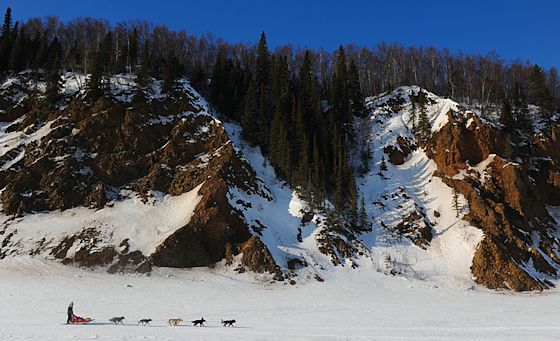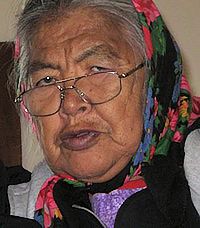Deg'Hit an Indians
The Deg Hit’an Indians (also known as Deg Xit’an, Deg Hitan, Degexit’an, Kaiyuhkhotana) are a group of Northern Athabascan peoples in Alaska.
They reside in Alaska along the Anvik River in Anvik, along the Innoko River in Shageluk, and at Holy Cross along the lower Yukon River.
The older name Ingalik (from the Yup’ik Ingqiliq “Indian”) and its derivatives are offensive to the Deg Hit’an people.
Their native language is called Deg Xinag.The Deg Hit’an are members of the federally recognized Alaska Native tribes of:
Anvik Village
Shageluk Native Village
Holy Cross Village.
The governing body for Anvik is the Anvik Tribal Council.
Article Index:
Anvik is a Deg Hit’an Athabascan community, with a rich history. It is located on the west bank of the Yukon River in Interior Alaska, just inside the old mouth of the Anvik River along the hillside. This hillside is called Deloy Ges (Hawk Bluff is the English name), which means “so-called mountain” in Deg Xinag, the local Athabascan language. Raven, or Yuxgitsiy, whose name translates as “everyone’s grandfather” created Deloy Ges.

Tribe: Anvik Village
Regional Corporation: Doyon, Limited
Regional Organization: Tanana Chiefs Conference
Village Government: Anvik Tribal Council
Address: P.O. Box 30, Anvik, AK 99558
Phone: (907) 663-6331
e-mail: carljerue@yahoo.com
Here is how our oral tradition explains creation of the mountain:
Raven was walking along. Soon he came across sand. He thought to himself, “I should make a mountain.” He piled up the sand real high, then started to walk up it with his cane. The sand started to slide down, as it does when you pile it up. Raven, he got mad and whipped it up with his cane; that’s what made all the gulches in the hillside. Then he walked away from it.
Anvik has been known by many names throughout the years, including: American Station, Anvic, Anvick, Anvig, Anvig Station, and Anwig. Anvik was originally sited across the Yukon River Northeast of its present location at a place called the point. Every year at breakup, families moved up into the hills from the point. Residents gradually moved to where the Anvik Episcopal mission, school and church were constructed in 1887 and a post office in 1897.
 There were two influenza epidemics, first in 1918, and again in 1927, which created many orphans. Children came from as far away as Fort Yukon to the mission.
There were two influenza epidemics, first in 1918, and again in 1927, which created many orphans. Children came from as far away as Fort Yukon to the mission.
Regular mail service was established in the mid-thirties when planes with skis and floats arrived at the village. Before the present airstrip was built in the mid-1960s, wheeled aircraft landed on nearby sandbars.
Anvik is also the first checkpoint on the Yukon River for the Iditarod Trail Sled Dog Race, when the sled dog race takes a southern route every other year. The church bell is always rung for the first team that arrives.
As of 2000, there were 104 people, 39 households and 23 families residing in the city. Ninety-four were American Indian. The annual median household income was $21,250, and the median family income was $18,125. Males had a median income of $0 versus $18,750 for females. The per capita income for the city was $8,081 (compare $21,587 nationally). Median rent was $263 and monthly housing and mortgage costs were $833. There were 40.0% of families and 44.2% of the population living below the poverty line.
In 2012, 88 people were living in Anvik (77 native American) and the estimated median household income in 2011 had dropped to $14,391. The average median income in Alaska as a whole in 2011 was $67,825. The median gross rent in 2011 in Anvik was $583.
Anvik Tribal Council is the governing body. This village is also a member of the Tanana Chiefs Conference, which includes:
-
Allakaket
-
Anvik
-
Beaver
-
Birch Creek
-
Dot Lake
-
Eagle
-
Grayling
-
Holy Cross
-
Hughes
-
Huslia
-
Koyukuk
-
Minto
-
Nenana
-
Nikolai
-
Rampart
-
Ruby
-
Shageluk
-
Stevens Village
-
Takotna
-
Tetlin
There are two other Deg Hit’an villages in Alaska, Shageluk Native Village along the Innoko River, and Holy Cross Native Village on the lower Yukon River.
The Deg Hit’an were once called by an older name Ingalik (from Yup’ik Ingqiliq “Indian”) and it and its derivatives are now considered offensive to the Deg Hit’an people.

